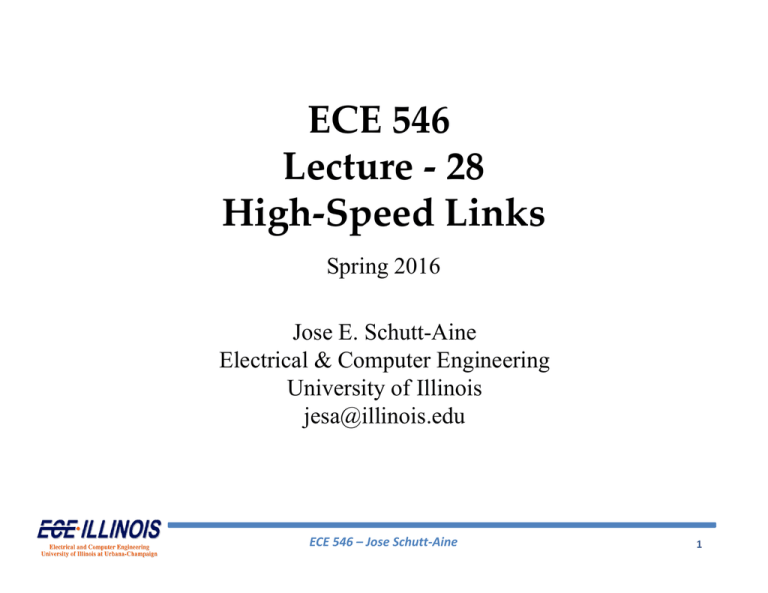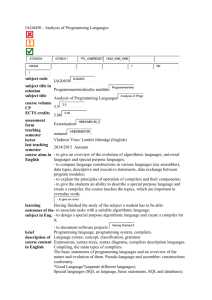ECE 546 Lecture - 28 High
advertisement

ECE 546 Lecture ‐ 28 High‐Speed Links Spring 2016 Jose E. Schutt-Aine Electrical & Computer Engineering University of Illinois jesa@illinois.edu ECE 546 – Jose Schutt‐Aine 1 Inter-IC Communication Trends ECE 546 – Jose Schutt‐Aine 2 High-Speed Bus and Networks Memory Bus (Single‐ended, Parallel) Cable (Differential, Serial) • DDR (4.266 Gbps) • USB (4.266 Gbps) • LPDDR4 (4.266 Gbps) • HDMI (4.266 Gbps) • GDDR (7 Gps) • Firewire: Cat 5, Cat 5e, Cat 6 • XDR (differential, 4.8 Gbps) Storage (Differential, Serial) • Wide IO2, HBM • eMMC, UFS (6 Gbps) • SAS, STATA (6 Gbps) Front Side Bus (Differential, Parallel) • FiberChannel (10 – 20 Gbps) • QuickPath Interconnect (6.4 Gbps) • HyperTransport (6.4 Gbps) Computer IO (Differential, Parallel) • PCIe (8 Gbps) • InfiniBand (10 Gbps) Ethernet (Differential, Serial) • XAUI (10 Gbps) • XFI (10 Gbps) • CEI‐6GLR • SONNET (10 Gbps) • 10GBase‐x, 100GBase (25 Gbps) ECE 546 – Jose Schutt‐Aine 3 Basic Serial Link Architecture ECE 546 – Jose Schutt‐Aine 4 Basic Serial Link Architecture ECE 546 – Jose Schutt‐Aine 5 Why SERDES? • Traditional parallel communication not suitable for inter‐IC data transport in high‐speed links. – • Serial links are most cost‐effective. – – • High design overhead due to cross‐talk, data‐skew. Parallel links = extra pins Higher packaging costs. Speed v/s cost tradeoff with serial links. Solution = SERDES!!! – – Parallel communication still used in internal buses of ICs thus a need for SerDes. Mitigate cost while maintaining high‐speeds with a fast serial‐parallel data conversion. ECE 546 – Jose Schutt‐Aine 6 What is a SERDES? • SERDES = SERializer – DESerializer – – – – Used to transmit high speed IO‐data over a serial link in I/O interfaces at speeds upwards of 2.5Gbps. SerDes TX: transmit parallel data to receiver overhigh speed serial‐link. SerDes RX: receive data from serial‐link and deliver parallel data to next‐stage. Advantage: Fast signaling, robust, high signal integrity. ECE 546 – Jose Schutt‐Aine 7 Serial Links in SoC: Oracle SPARC T5* About 50 SerDes IPs – Single IP power & area – Integrated with SoC – Portable with SoC * J. Hart et al., "A 3.6GHz 16-Core SPARC SoC Processor in 28nm", Proceedings of the 2013 IEEE International Solid-State Circuits Conference. ECE 546 – Jose Schutt‐Aine 8 Serializer/Deserializer Blocks • Serializer: • Deserializer ECE 546 – Jose Schutt‐Aine 9 Embedded Clock Architecture Converts parallel data into serial data (Tx side) Applies equalization to the data stream Converts serial data into parallel data (Rx side) ECE 546 – Jose Schutt‐Aine 10 Forwarded Clock Architecture Additional lane for delivering the clock Jitter introduced by the clock can be canceled at receiver Offers better jitter performance ECE 546 – Jose Schutt‐Aine 11 DC and AC Coupling AC Coupled Link AC coupling has advantage of isolating common‐mode voltage levels between RX and TX Terminated to VCC DC Coupled Link Terminated to VSS Terminated to Vcm ECE 546 – Jose Schutt‐Aine 12 Transmitter Need large enough voltage swing Pre‐driver is used to deliver large enough swing to Tx FFE can be realized anywhere along data path ECE 546 – Jose Schutt‐Aine 13 Current-Mode Driver • Group of differential pairs • Arranged in a binary weighted form • Controlled by 6-bit equalized data ECE 546 – Jose Schutt‐Aine 14 Current-Mode Driver DC-Coupled Link AC-Coupled Link ECE 546 – Jose Schutt‐Aine 15 Receiver • Receives data • Performs equalization • Recovers data and clock ECE 546 – Jose Schutt‐Aine 16 Link Classification • Number of data bits per clock cycle • Need multiple phases for half rate and quarter rate ECE 546 – Jose Schutt‐Aine 17 Signaling Protocol NRZ vs RZ ECE 546 – Jose Schutt‐Aine 18 Clock Synthesizer ECE 546 – Jose Schutt‐Aine 19 PLL Overview Basic PLL Block Diagram: • Closed‐loop feedback system that synchronizes the output CLK phase with that of the reference CLK. • Tracks phase changes w/i the specified BW. • Idea is that the PD (Phase Detector) will compare the reference CLK phase with that generated by the VCO. – Goal: Stabilize Δ → 0 such that VCO output CLK and reference CLK are locked at same frequency and phase. – Tracks low‐frequencies but rejects high‐frequencies. ECE 546 – Jose Schutt‐Aine 20 Why need PLLs? • Reduces jitter. • Reduces clock‐skew in high‐speed digital ckts. • Instrumental in frequency synthesizers. • Essential building block of CDRs. ECE 546 – Jose Schutt‐Aine 21 PLL Building Blocks Basic PLL Components: • PD/PFD ~ Phase/Phase+Frequency Detector • CP ~ Charge pump circuit • LF ~ Loop‐Filter • VCO ~ Voltage controlled oscillator • Frequency Divider ECE 546 – Jose Schutt‐Aine 22 PD/PFD Circuits Common PD Implementations: Common PFD Implementations: XOR PD Gilbert‐cell Mixer • PD/PFD are strictly digital circuits in high speed SerDes transceivers. • Ideal PD is a “multiplier” in time‐domain, ex: Mixer • Analog PD High Jitter, noise. • XOR PD sensitive to clock duty cycle • PFD ~ best to lock phase and frequency! ECE 546 – Jose Schutt‐Aine 23 PFD Theory 1. PFD is needed to adjust the control voltage for VCO according to the phase difference between the VCO output and reference frequency 2. PFD can be seen as a state machine with three states. It will change the control voltage of VCO according to its current state and phase/frequency difference will cause state transition. ECE 546 – Jose Schutt‐Aine 24 PFD Analysis 1. PFD is in state 0 with no phase difference. 2. PFD is in state 1 with positive phase difference. 3. PFD is in state ‐1 with negative phase difference. ECE 546 – Jose Schutt‐Aine 25 PFD Design Overview Charge pump Down circuit UP circuit Phase Frequency detector ECE 546 – Jose Schutt‐Aine 26 PFD Simulation ECE 546 – Jose Schutt‐Aine 27 The Hogge Phase Detector • Two Functions – Transition detection – Phase Detection ECE 546 – Jose Schutt‐Aine 28 The Charge Pump • Combination of current source and sink • Converts PD output to a current pulse influencing control voltage of VCO ECE 546 – Jose Schutt‐Aine 29 Charge-Pump Circuit Common CP Implementations: • Used in conjunction with PFD over PD+LF combo. b/c: – Higher capture/lock acquisition range of PLL 0 provide no device mismatch exists. – Δ – Provide infinite gain for a static phase‐error ECE 546 – Jose Schutt‐Aine 30 The Loop Filter • Low‐pass for rejection of high frequency noise • Forms the control voltage of the VCO ECE 546 – Jose Schutt‐Aine 31 Loop-Filter Common LF Implementations: • Extracts average of PD error signals generate VCO control voltage. • Integrates low‐frequency phase‐errors on C1 to set avg. freq. • R adds thermal noise, C1 determines loop BW, C2 smoothens control voltage ripple. ECE 546 – Jose Schutt‐Aine 32 Loop-Filter Design 1. Needed to filter out high frequency noise generated by PFD 2. Due to the superior performance of PFD, only a passive second order RC low pass filter is needed. Where Assuming 25MHz Low pass filter for current input ECE 546 – Jose Schutt‐Aine 33 Voltage Controlled Oscillator • Generates an output with oscillation frequency proportional to the control voltage • Helps the CDR accumulate phase and achieve lock ECE 546 – Jose Schutt‐Aine 34 VCO Common VCO Implementation: LC‐Tank Oscillator • Extracts average of PD error signals generate VCO control voltage. • PLL acts like a High‐pass filter with respect to VCO jitter. • VCO always has one pole! ECE 546 – Jose Schutt‐Aine 35 Oscillators Overview • Closed‐Loop Transfer function: – • Barkhausen’s criteria for oscillation: – – • = oscillation‐frequency. ECE 546 – Jose Schutt‐Aine 36 Ring v/s Tank Architecture Ring Structure LC‐Tank Structure 1. Low‐power, highly integrated. 1. High‐power, not integrable. 2. Occupies smaller die‐area. 2. Occupies large die‐area. 3. Poor‐performance at high‐ frequency due to large phase‐noise + jitter. 3. Great phase‐noise and jitter performance at high frequency. 4. Can only accept digital signals. 4. Can accept analog and digital signals. ECE 546 – Jose Schutt‐Aine 37 MOS Varactor ECE 546 – Jose Schutt‐Aine 38 Cascode MOS Varactor ECE 546 – Jose Schutt‐Aine 39 LC-Tank VCO Designs - I ECE 546 – Jose Schutt‐Aine 40 LC-Tank VCO Designs - II ECE 546 – Jose Schutt‐Aine 41 LC-Tank VCO Designs - III ECE 546 – Jose Schutt‐Aine 42 LC-Tank VCO Designs - Final ECE 546 – Jose Schutt‐Aine 43 Final VCO Design Parameters M1 L = 100n, W = 2u M2 L = 100n, W = 2u M3 L = 100n , W = 2u M4 L = 100n, W = 2u M5 L = 500n, W = 10u M6 L = 500n, W = 10u M7 L = 500n, W = 10u M8 L = 500n, W = 10u M9 L = 100n, W = 2u M10 L = 50n, W = 2u L 1.5nH, Q = 5 R 465 Ω ECE 546 – Jose Schutt‐Aine 44 Fractional N-Divider Simulation ECE 546 – Jose Schutt‐Aine 45 VCO Jitter Analysis ECE 546 – Jose Schutt‐Aine 46 Theoretical Design Overview • • • – Recall, • , , ECE 546 – Jose Schutt‐Aine 47 Fractional N-Divider Circuit 1. Needed to slow down the VCO’s output so that PFD can compare it with reference frequency. 2. N D‐FlipFlops cascaded together to achieve divider. Fractional 8 Divider Positive edge‐triggered DFF using split‐output latches ECE 546 – Jose Schutt‐Aine 48 Complete PLL Circuit ECE 546 – Jose Schutt‐Aine 49 Complete PLL Simulation ECE 546 – Jose Schutt‐Aine 50 Complete PLL Jitter Analysis ECE 546 – Jose Schutt‐Aine 51 Equalization ECE 546 – Jose Schutt‐Aine 52 Channel ECE 546 – Jose Schutt‐Aine 53 Equalization ECE 546 – Jose Schutt‐Aine 54 Equalization Off-chip bandwidth scales at a much lower rate than on-chip bandwidth. Primary objective is to have low bit error rate (BER). Typical BER is 10-12. ECE 546 – Jose Schutt‐Aine 55 Channel Equalization ECE 546 – Jose Schutt‐Aine 56 Equalization Techniques ECE 546 – Jose Schutt‐Aine 57 Pre‐Emphasis and Equalization • Pre-emphasis boosts the high-frequency contents of the signal at the transmitter before the signal is sent through the channel. • A two-tap finite impulse response (FIR) filter is an example of pre-emphasis implementation. • Pre-emphasis has high power requirements, aggravates crosstalk and increase EMI. • Pre-emphasis cannot improve SNR • Data converters are required to implement preemphasis ECE 546 – Jose Schutt‐Aine 58 Receiver Equalization • The loss in the channel is suppressed by boosting the high-frequency content of the signal. • Often results in larger noise margins. • Receivers can be implemented in discrete-time or continuous time. • Implementations include digital FIR equalizer, analog FIR equalizer, continuous time equalizer. ECE 546 – Jose Schutt‐Aine 59 Continuous Time Passive Equalizer 1 z R1C1 P 1 R2 DC gain R1 R2 R1 R2 C1 C2 R1 R2 R2 1 R1C1s H (s) R1 R2 1 R1 R2 C C s 1 2 R1 R2 ECE 546 – Jose Schutt‐Aine 60 Channel-Equalization Typical Channel Response w/o Equalization: • Equalization at TX and RX needed to counter the effects of channel, properly decode signals. • TX: FFE (Feed‐Forward Equalizer) • RX: DFE (Decision‐Feedback Equalizer) D. R. Stauffer et al., “High Speed Serdes Devices and Applications”, Springer 2008 ECE 546 – Jose Schutt‐Aine 61 FFE Circuit Architecture Typical Channel Response at Receiver with FFE at TX: Sample 3‐tap FFE Architecture: D. R. Stauffer et al., “High Speed Serdes Devices and Applications”, Springer 2008 ECE 546 – Jose Schutt‐Aine • FFE taps selected to generate a filter with the inverse transfer‐ function as that of channel. • Trade‐off b/w signal amplitude at receiver and jitter. 62 DFE Circuit Architecture Typical Channel Response at Receiver with DFE at RX: Sample 5‐tap DFE Architecture: • • D. R. Stauffer et al., “High Speed Serdes Devices and Applications”, Springer 2008 ECE 546 – Jose Schutt‐Aine DFE is needed in links with a high‐baud rate to min. signal ampl. at high freq. caused by channel jitter. Filter weights selected dynamically in a feedback loop to max. eye opening. 63 FFE vs. DFE • FFE • DFE • Can mitigate the pre‐cursor channel response in low‐BW channels. • Cannot equalize ISI arising from pre‐cursor channel response. • Can compensate ISI arising from transient TL loss over wide time‐spans. • Can only compensate ISI from a fixed time‐span. FFE + DFE • Guarantees max. performance from the SerDes. • Advantage: – DFE permits use of low‐frequency de‐emphasis at TX resulting in a larger received signal envelope, smaller signal/crosstalk ratio. – System capable of employing continuous adaptive equalization of its feedback taps to optimize performance. ECE 546 – Jose Schutt‐Aine 64 The CDR Circuit ECE 546 – Jose Schutt‐Aine 65 CDR Circuit Overview • Monitor data signal transitions and select optimal sampling phase for the data at midpoint between edges. • Extracts clock information from incoming data stream and uses this regenerated clock to resample the data waveform and recover the data. • Non‐linear circuit and key block to limit jitter, noise within the SERDES circuit. ECE 546 – Jose Schutt‐Aine 66 Basic Idea • Serial data transmission sends binary bits of information as a series of optical or electrical pulses • The transmission channel (coax, radio, fiber) generally distorts the signal in various ways • From this signal we must recover both clock and data ECE 546 – Jose Schutt‐Aine 67 10 Gigabit Ethernet Serializer ECE 546 – Jose Schutt‐Aine 68 10 Gigabit Ethernet Deserializer ECE 546 – Jose Schutt‐Aine 69 Universal Serial Bus (USB) Full-speed Cable Delay ECE 546 – Jose Schutt‐Aine 70 Universal Serial Bus (USB) One-way Propagation Delay Low-speed Cable Delay • The cable delay must be less than 5.2 ns per meter. • The maximum delay allowed is 30 ns. • Allocation for cable delay is 26 ns ECE 546 – Jose Schutt‐Aine 71 Universal Serial Bus (USB) ECE 546 – Jose Schutt‐Aine 72 Serial Link ‐ Passive channel consists of linear elements (TL, package) ‐ Analog channel includes TX driver and RX termination network ‐ End‐to‐end channel includes everything ECE 546 – Jose Schutt‐Aine 73 High-Speed Serial Channels High speed Serial channels are pushing the current limits of simulation. Models/Simulator need to handle current challenges – Need to accurately handle very high data rates – Simulate large number of bits to achieve low BER – Non-linear blocks with time variant Systems – TX/RX equalization and vendor specific device settings – Coding schemes – All types of jitter: (random, deterministic, etc.) – Crosstalk, loss, dispersion, attenuation, etc… – Clock Data Recovery circuits – TX and RX may come from different vendors ECE 546 – Jose Schutt‐Aine 74 ECE 546 – Jose Schutt‐Aine 75 Timing Margin ECE 546 – Jose Schutt‐Aine 76 Timing Jitter ECE 546 – Jose Schutt‐Aine 77 Serial Channel Characterization • Millions of bits of behavior are needed to adequately characterize serial links long simulation times • SERDES transmitters / receivers can be modeled as a combination of analog & algorithmic elements • Serial channels can be characterized using S Parameter data and/or other passive interconnect models ECE 546 – Jose Schutt‐Aine 78 Simulation Methods Analysis Method Advantages Drawbacks IBIS Fast Not accurate Device Level Accurate Nonlinear Very slow IP liability Fast convolution Very fast Handles EQ Include bit patterns Not Silicon Specific Assumes LTI Statistical Very Fast Handles EQ Not silicon specific No bit patterns Assumes LTI IBIS‐AMI Fast Handles Vendor EQ Includes Bit Patterns Not limited to LTI Implementations vary ECE 546 – Jose Schutt‐Aine 79 Industry Standard: IBIS • • • • • Provided as binary code Fast, efficient execution Protects vendor IP Extensible modeling capability Allows models to be developed in multiple languages • Standardized execution interface • Standardized control (.AMI) file IBIS homepage: http://www.eigroup.org/ibis/ ECE 546 – Jose Schutt‐Aine 80 AMI • AMI stands for Algorithmic Modeling Interface faster signal processing algorithms intellectual property protection used in convolution transient engines designed to be used with fixed time step data introduced in IBIS 5.0 specs in these specs the library is specified inside the IBIS wrapper IBIS stands for “I/O Buffer Information Specification”; high-level buffer specification for circuit modeling http://eda.org/pub/ibis/ver5.0/ver5_0.txt ECE 546 – Jose Schutt‐Aine 81 AMI Challenges • AMI models are compiled DLLs and text files – No graphical representation • Package model standard not finalized – User needs to manually add IC/package parasitics to channel model • Each IC vendor has different parameter set – No standards set – Each vendor must document their models • No standard way to sweep parameters – Need to create multiple .AMI files – EDA tools need to parse arbitrary .AMI parameters ECE 546 – Jose Schutt‐Aine 82

